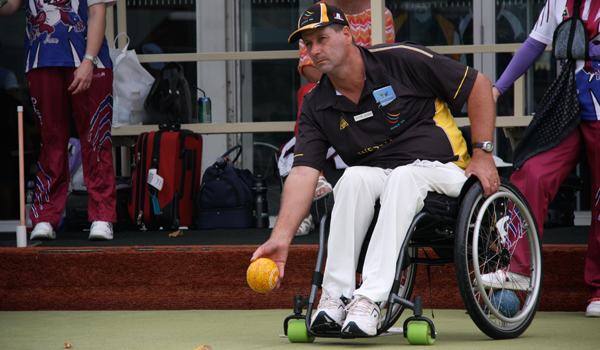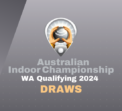Inaugural Multi Disability Championships
Saturday 18th and Sunday 19th of April Bowls WA is hosting the inaugural WA Multi-Disability State Championships on Saturday 18th and Sunday 19th of April 2015, playing Singles and Pairs.
Click here to download the Multi Disability State Championships Entry Form
This event is open to four disability areas: Vision, Deaf, Physical and Intellectual.
By participating in these games bowlers are opening up the opportunity for a state title as well as the possibility of further competition in the following tournaments:
1. The Australian Open,
2. The Disability Sport Australia (DSA) National Multi-Disability Championships, and
3. International Bowlers with Disability (IBD) tournaments.
4. Additionally, there is further opportunity for bowlers using Bowling Arms to form a State team to attend the National Bowlers Arm Interstate Challenge (currently NSW, VIC, SA).
DSA performs the role of a National Coordinating Body, providing a single point of contact between the Australian Sports Commission (ASC), the Australian Paralympic Commission (APC), and National Sporting Organizations (NSO). In our case, the NSO is Bowls Australia.
It can be hard defining what a disability is and DSA follows the International Paralympic Commissions (IPC) definition of Athletes with a Disability using a Classification system.
The eight levels for physical and visual impairment are listed below, followed by further definitions of Intellectual Disability and Deaf Impairment.
IPC CLASSIFICATIONS:
B1: Totally blind, no light perception in either eye up to light perception but the inability to recognise the shape of a hand at any distance or in any direction.
B2: Partially sighted, ability to recognise the shape of a hand up to a visual acuity of 2/60 and/or visual field of less than 5 degrees
B3: Partially sighted, visual acuity above 2/60 up to 6/60 and/or visual field of more than 5 degrees and less than 20 degrees.
B4: Severely disabled bowlers such as tetraplegics or severe cerebral palsy, unable to use a bowl larger than 64mm diameter.
B5: Ambulant and wheelchair bowlers with restricted grip and upper body limb function, poor balance and co-ordination, unable to bowl a full length end or needing a splinting device to do so.
B6: Ambulant and wheelchair bowlers with reduced balance function (loss of 5 points or more) but able to bowl a full length end.
B7: Ambulant and wheelchair bowlers with minor balance problems (loss of less than 5 points).
B8: Ambulant bowlers, who have a permanent and irreversible disability, have lost 10 points on the bench test, but have no noticeable impairment of function.
Athletes who participate in Paralympic sport are grouped into ten major categories, based on their type of disability:
(1-8) Physical Impairment – There are eight different types of physical impairment:
Impaired muscle power – With impairments in this category, the force generated by muscles, such as the muscles of one limb, one side of the body or the lower half of the body is reduced, (e.g. due to spinal-cord injury,spina bifida or polio).
Impaired passive range of movement – Range of movement in one or more joints is reduced in a systematic way. Acute conditions such as arthritis are not included.
Loss of limb or limb deficiency – A total or partial absence of bones or joints from partial or total loss due to illness, trauma, or congenital limb deficiency (e.g. dysmelia).
Leg-length difference – Significant bone shortening occurs in one leg due to congenital deficiency or trauma.
Short stature – Standing height is reduced due to shortened legs, arms and trunk, which are due to a musculoskeletal deficit of bone or cartilage structures.
Hypertonia – Hypertonia is marked by an abnormal increase in muscle tension and reduced ability of a muscle to stretch. Hypertonia may result from injury, disease, or conditions which involve damage to the central nervous system (e.g. cerebral palsy).
Ataxia – Ataxia is an impairment that consists of a lack of coordination of muscle movements (e.g. cerebral palsy, Friedreich’s ataxia).
Athetosis – Athetosis is generally characterized by unbalanced, involuntary movements and a difficulty maintaining a symmetrical posture (e.g. cerebral palsy, choreoathetosis).
(9) Visual Impairment – Athletes with visual impairment ranging from partial vision, sufficient to be judged legally blind, to total blindness. This includes impairment of one or more component of the visual system (eye structure, receptors, optic nerve pathway, and visual cortex).
(10) Intellectual Disability – Athletes with a significant impairment in intellectual functioning and associated limitations in adaptive behaviour. The IPC primarily serves athletes with physical disabilities, but the disability group Intellectual Disability has been added to some Paralympic Games.
Deaf Impairment – People who are born deaf or became deaf at an early age (before language acquisition). Deaf people identify themselves as part of a Deaf Culture and Community and are likely to use Auslan (Australian Sign Language) as a first or preferred language.
Bowls WA is very excited about this newest opportunity and we look forward to hosting the 2015 WA Multi-Disability State Championships.
If you have further questions contact Denise McMillan, Bowls WA Inclusive Practices Officer, by email – denise@bowlswa.com.au or mobile – 0449 619 841.



